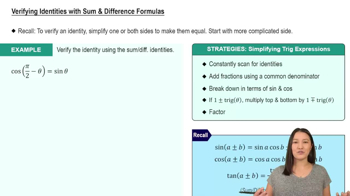Textbook Question
In Exercises 57–64, find the exact value of the following under the given conditions:a. cos (α + β)3 3𝝅 1 3𝝅 tan α = ------ , 𝝅 < α < -------- , and cos β = ------- , ---------- < β < 2𝝅.4 2 4 2
767
views
 Verified step by step guidance
Verified step by step guidance Verified video answer for a similar problem:
Verified video answer for a similar problem:



 6:14m
6:14mMaster Sum and Difference of Sine & Cosine with a bite sized video explanation from Patrick
Start learning